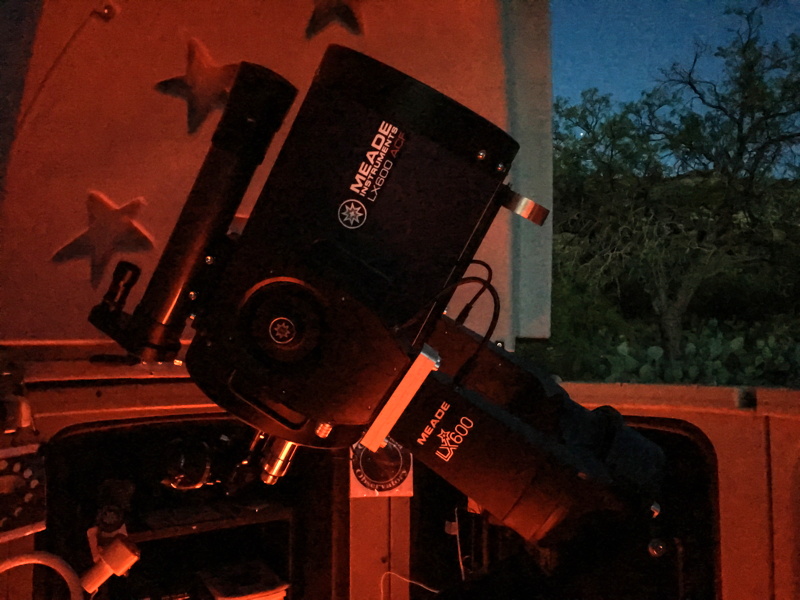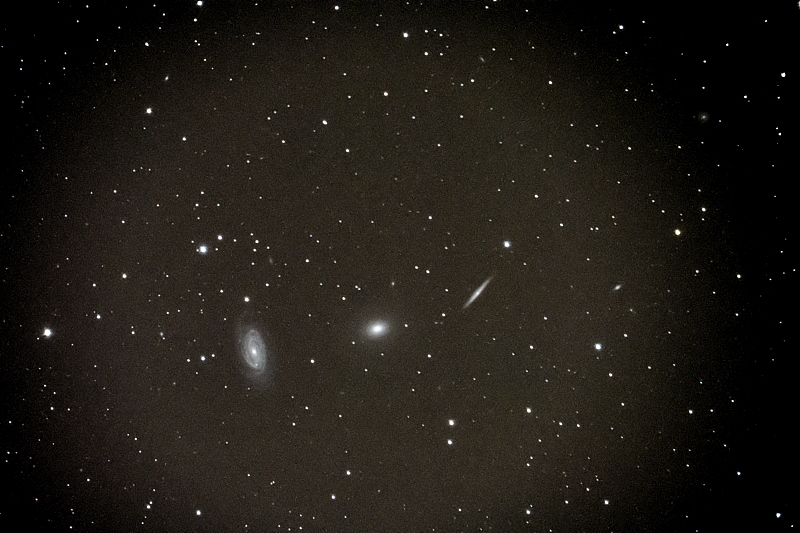Imaging: ISS, Galaxies, Galaxies, and More Galaxies
Posted: 16 April 2017
On my previous session I took some test exposures of the sky through the telescope to get some good examples of vignetting in the image corners. I had hoped to be able to create a "lens profile" for Adobe Lightroom that would automatically correct the vignetting. Unfortunately, that experiment did not work out. I also briefly considered using the Adobe Lens Profile Creator program to create a telescope "lens profile" but that would require a checkboard chart be mounted some unknown distance away from the telescope, and would probably not work out. A reader had suggested a program called "Affinity Photo" which he used to correct image vignetting. Might have to try that.
|
Open: Saturday, 15 April 2017, 1823 MST Temperature: 90°F |
Session: 1099 Conditions: Clear |
Equipment Used:
12" f/8 LX600 w/StarLock
2" 24mm UWA eyepiece
2" 9mm 100° eyepiece
Camera:
D7200 DSLR
After opening the observatory and then waiting for sunset I enjoyed relaxing on the observatory patio bench.
1855 MST: sunset.
1857 MST: LX600 ON, StarLock OFF, High Precision OFF.
Slewed to the star Procyon and checked the finderscope alignment; OK. Updated the TLE for this night's good pass of the International Space Station (ISS).
Then returned to the bench to await darkness. This is how the observatory looked from my perspective reclining on the bench:

As I was relaxing on the bench I saw Jupiter rising through a tree. This iPhone 6s Plus photo shows the telescope with rising Jupiter in the tree:

1928 MST: went back inside of the observatory. Began preparations for the upcoming ISS pass. While doing the preps I noticed that the Zodiacal Light was very bright this evening. Mounted the D7200 DSLR at prime focus, focused on the star Procyon, and locked the 12" telescope primary mirror. 2005 MST: ready for the ISS pass, which would start behind a tree.
Using the D7200 DSLR I did an HD video recording at prime focus, 1/2000sec, ISO 2500. The recording lasted 4m 24s and almost completely covered the pass. Here are 11 images of the ISS from the video showing the changing perspective and brightness of the Space Station during the pass:

2020 MST: mounted the DSLR at prime focus + focal reducer. Focused on the star Denebola. Slewed to the Coma Galaxy Cluster (Abell 1367) to begin the night's imaging of galaxies. 2031 MST: StarLock ON. Over the next 2h 20m I imaged galaxies, galaxies, and more galaxies. Here are the results:
Coma Galaxy Cluster (Abell 1367), 5 minutes, ISO 6400, White Balance Auto:

NGC4676 (colliding galaxies), 5 minutes, ISO 6400, White Balance 3570K:

NGC5395 (colliding galaxies), 5 minutes, ISO 6400, White Balance 3570K:

NGC4565 (Needle Galaxy), stack of 5 1 minute exposures, ISO 6400, White Balance 3570K:

NGC5529 (galaxy), 5 minutes, ISO 6400, White Balance 3570K:

NGC2936 (colliding galaxies), 5 minutes, ISO 6400, White Balance 3570K:

NGC4038 (colliding galaxies), 5 minutes, ISO 6400, White Balance 3570K:

Draco Galaxy Trio (NGC5985/5982/5981), 5 minutes, ISO 6400, White Balance 3570K:

NGC6622 (colliding galaxies), 5 minutes, ISO 6400, White Balance 3570K:

2251 MST: StarLock OFF. Ended imaging. Unmounted the camera.
2300 MST: Eastern sky brightening due to the rising waning gibbous Moon. Breezes began.
Viewed the globular clusters M92 and M13, 102X. Nice sights. Always a joy to see the Great Globular in Hercules (M13), now returning to the night sky.
Then viewed Jupiter, 102X and 271X. The four Galilean Moons were visible.
The last object viewed this night was M104 (Sombrero Galaxy), 102X.
2315 MST: LX600 OFF.
|
Close: Saturday, 15 April 2017, 2326 MST Temperature: 60°F |
Session Length: 5h 03m Conditions: Clear, breezy |
Comments are welcome using Email. Twitter users can use the button below to tweet this report to your followers. Thanks.
Cassiopeia Observatory Home Page
Copyright ©2017 Michael L. Weasner / mweasner@me.com
URL = http://www.weasner.com/co/Reports/2017/04/16/index.html
